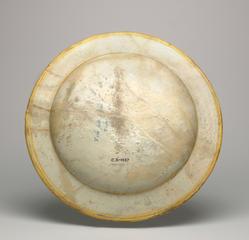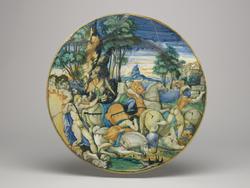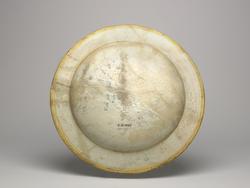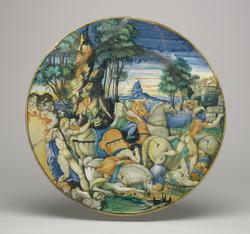Current Location: In storage
Titles
Apollo slaying the Sons of Niobe
Maker(s)
Workshop:
Guido di Merlino
(Possibly)
Painter:
Polidoro da Caravaggio (Polidoro Caldara)
(After)
Painter:
Giulio Romano (Giulio Pippi)
(After)
Entities
Categories
Description
Earthenware, in-glazed overall; the reverse pale beige. Painted in blue, green, yellow, orange, stone, brown, manganese-purple, black, and white. Shape approximately 64 with plain rim. Circular with almost flat rim, and wide shallow well; warped in firing. Apollo slaying the Sons of Niobe. Apollo stands on the left, firing his bow towards the stampeding horses of the sons of Niobe, five of whom are wholly or partly visible. Behind Apollo is the head of an old man. Further back to left there is a group of trees on either side of a rock, and to right, the citadel of Cadmus and two trees. In the distance there is a landscape with a mountain. A black band and a wider yellow band encircle the outer edge. The back is inscribed in the middle in blue: `Febbo saetto li ffillole de/Niobbe .548' (Phoebus shoots the sons of/Niobe).
Notes
History note: Conte Ferdinando Pasolini Dall'Onda, Faenza; sold Paris, Ridel, 14 December 1853, Catalogue d'une belle collection de majoliques italiennes des diverses fabriques des XVe, XVIe & XVIIe siècles dont la vente aura lieu Rue des Jeuneurs n. 42, salle 2., lot 212. Perhaps Joseph Marryat; Christie's, 16 February 1866, Catalogue of works of art formed during a long series of years by Joseph Marryat Esq., author of the well-known work on `Pottery and Porcelain', p. 52, lot 850. Charles Ricketts, RA (1866-1931) and Charles H. Shannon, RA (1863-1937) ; Charles H. Shannon RA by whom bequeathed
Legal notes
The Ricketts and Shannon Collection. Bequeathed by Charles Shannon, 1937
Measurements and weight
Height: 4 cm
Acquisition and important dates
Method of acquisition: Bequeathed
(1937)
by
Shannon, Charles Haslewood
Dating
16th Century, Mid
Renaissance
Production date:
dated
AD 1548
Note
On the right of the dish the painter has substituted a semi-clad male figure for the clad female figure in the original. It was probably inspired by a man astride a fallen horse in Giulio Romano's fresco of the 'Battle of the Milvian Bridge' in the Sala di Costantino in the Vatican, although the position of the figure has been reversed and the arms raised to approximate with the pose of the woman in the frieze. There does not appears to have been a print of the fresco when the dish was made so the man must have been derived from a drawing. The engraving with that title by Giulio Bonasone, dated 1544, depicts a different battle scene.
The design was derived from the facade of the Palazzo Milesi, via della Maschera d'Oro, Rome, which Polidoro da Caravaggio (1492-1543) completed before the Sack of Rome in 1527. It was the most celebrated of his facades and was the last of those listed by Vasari. The facade has deteriorated so that only the faintest shadows of its former splendour remain. But the whole scheme can be seen in Enrico Maccari's 'Graffiti e chiaroscuri esistenti nell'esterno delle case di Roma', undated but published in 1876. The frieze illustrating the story of Niobe ran from left to right along the facade above the doorways and below the first-floor windows. No print of this facade is known before 1548 so presumably the painter of the dish had access to drawings made in Rome.
School or Style
Renaissance
People, subjects and objects depicted
Components of the work
Decoration
composed of
high-temperature colours
( metallic oxide colours)
Rim
Diameter 42.8 cm
Materials used in production
Tin-glaze
Earthenware
Techniques used in production
Moulding
: Earthenware, tin-glazed overall; the reverse pale beige. Painted in blue, green, yellow, orange, stone, brown, manganese-purple, black, and white.
Tin-glazing
Inscription or legends present
- Text: Febbo saetto li ffillole de/Niobbe .548
- Location: On the back
- Method of creation: Painted
References and bibliographic entries
Related exhibitions
Identification numbers
Accession number: EC.3-1937
Primary reference Number: 47189
Stable URI
Audit data
Created: Saturday 6 August 2011
Updated: Tuesday 30 April 2024
Last processed: Tuesday 2 September 2025
Associated departments & institutions
Owner or interested party:
The Fitzwilliam Museum
Associated department:
Applied Arts

 IIIF Manifest
IIIF Manifest








